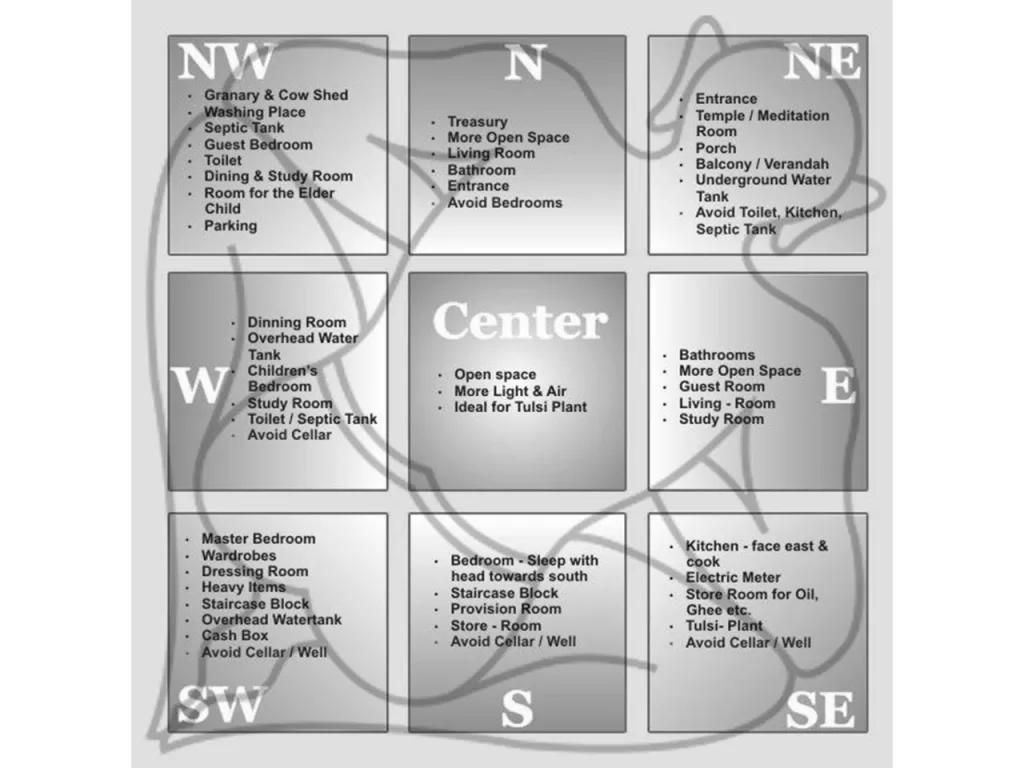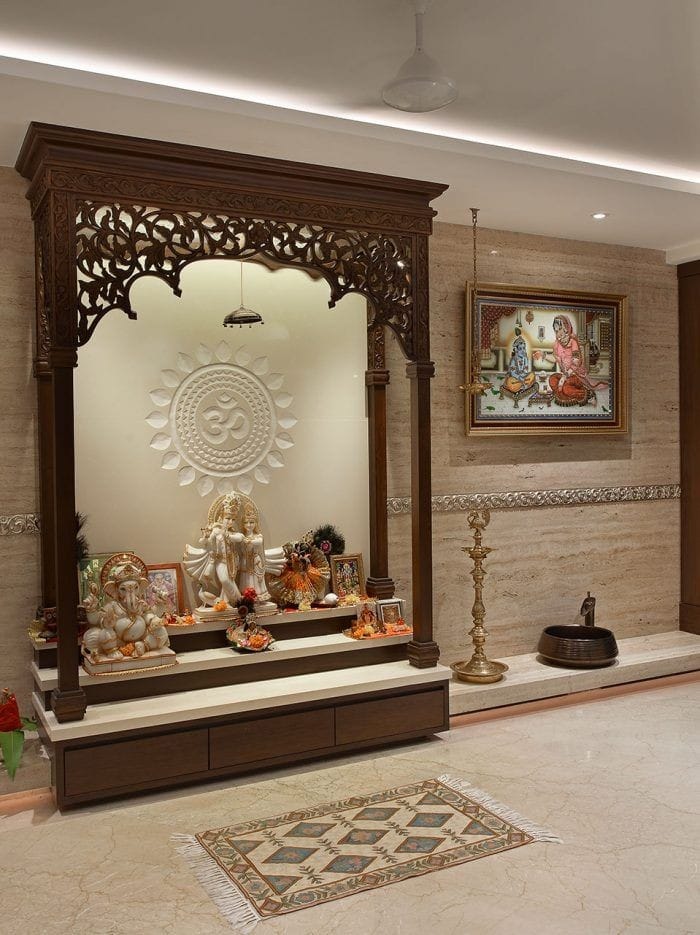Vaastu shastra, commonly referred to simply as Vaastu, is an ancient Indian architectural design system describing the principles of architecture and design the word “Vaastu” comes from Sanskrit and means “dwelling” or “dwelling”. Architecture is viewed as a guideline for creating a harmonious and balanced dwelling in harmony with the forces and dynamics of nature.
The basic principles of Vaastu include:
Orientation: Good conformity of the building to the general guidelines is considered important in Vaastu Nagar. The placement of objects such as doors, gates, circles is usually based on the direction of the compass.
Elements: Vaastu includes the five elements (Panchabhutas) – earth, water, fire, air and space. The balance of these elements in the system is thought to promote positive energy and well-being.
Energy Flow: Vaastu emphasizes the importance of free and positive flow of energy. Enclosed or cluttered spaces are believed to block the natural flow of energy.
Room placement: It is recommended that specific rooms be arranged in a particular style in a house. For example, a southwest orientation of the main bed is often recommended for stability and cohesion.
Sacred Space: Vaastu encourages the creation of a sacred space within the home, such as a prayer room or meditation area, to enhance spiritual well-being.

Orientation
Orientation is the first point in Vaastu shastra. with the orientation of the structure determined by the precise alignment of the structure with the principal directions. The four main directions are north, south, east and west. It is believed that a building that successfully conforms to these guidelines can have a positive impact on both energy flow and occupant well-being. each direction holds its importance.
North-East Direction: These directions are considered auspicious. Placing the main entrance or important rooms (study room or home office) in the northern or eastern parts of the building is believed to invite positive energy and prosperity.
North Direction: This direction belongs to water and money. North direction in your home or by each room should remain light and all heavy stuff like almirah, cupboard, or any electronics must not be on north side of home or room.
East Direction: This direction belongs to sun, because sun rises in the east. East direction in your home or each is perfect for you to do work, you should do work while facing east or better if you work on computer or laptop put your table on the eastern wall of your room or home office, sun enlighten your mind and you will excel in your work.
Home Office related Floating Desk vs Normal Desk, Which One you Should buy? – Maxima Living
West Direction: This direction belongs to the happiness of family members. if you west direction is not well maintained then your family happiness will suffer, to prevent that from happening, maintain your home or room west direction by putting your family photos on west wall in some designed beautiful sleek photo frames which makes you remember those loving memories with your family.
Thing you can buy for your Living Room- Maxima Living
South Direction: This Direction belongs to your forefathers. and it also belong to God of Death (Yamraj) according to Hindu scriptures and epics. it is very important to be cautious while applying vaastu to south direction in your home or room. South side must remain heavy for example all heavy furniture or heavy items must be place on southern wall of your home or room. by heaving this side, you are blocking negative energy or vibes to enter in your home or room.

Elements
Vaastu shastra includes the consideration of the five elements of the five elements. These elements are earth (earth), water (water), fire (fire), air (wind), and space (sky). It is believed that the balance of these elements and the harmonious interaction within a building contribute to a healthy and harmonious life. Here is an explanation of how these factors are considered in Vaastu.
Earth (Earth): This element is associated with stability and support. Vaastu is also thought to provide stability and grounding to the space through earth color, complexity of building materials and proper placement of heavy furniture or structures.
Water (Water): Water, the symbol of purity, is considered essential for life. It is recommended that bodies of water, such as wells, reservoirs and tanks, be properly routed in a specific direction to ensure efficient energy flow.
Fire (Fire): Fire is associated with energy and change. The kitchen, which represents the fire element, is generally placed in the southeast direction according to architectural principles. Balanced natural sunlight and adequate ventilation are considered important in the firefighting process.
Wind (wind): Wind represents movement and circulation. City design emphasizes fresh air, windows and open spaces that allow air to flow freely throughout the building. Oxygen is believed to promote health and well-being.
Space (sky): Space takes the other four elements. In architecture, it is considered important to create open and uncluttered spaces for the flow of positive energy. It is believed that the presence of vacant space or sediment allows energy to travel freely.

Energy Flow
The building materials are related to the concept of energy flow through a structure. Vaastu emphasizes the importance of ensuring a free and healthy flow of energy, as blocked or stagnant energy is believed to have a negative impact on the well-being of residents Key sources of energy a flows in Vaastu include:
Open spaces and pathways: Vaastu suggests that the design of a building should have simple pathways and open spaces to allow the energy to flow smoothly It is thought that cluttered or cramped spaces hinder the flow of positive energy.
Main Entrance: The main entrance, commonly referred to as the “front of the house,” is considered an important area for forced entry. Keeping the entry area clean, well-lit and welcoming is recommended to bring positive energy into the home.
Ventilation and Natural Light: Adequate ventilation and natural light are believed to contribute to efficient energy penetration. Well-ventilated spaces are considered healthy, and natural light is thought to bring good results.
Avoiding Obstructions: Vaastu advises not to put obstacles or obstacles in the paths of energy. For example, vertical alignment of furniture, walls and other obstructions in the center of the home can interfere with energy circulation.
Balancing Elements: Balancing the various installations in a space is essential to maintaining a healthy flow of energy. This also includes the proper arrangement of furniture, decorations and functional elements to create a harmonious and balanced environment.

Room placement
According to Vaastu principles, aligning certain rooms with specific directions is believed to bring positive energy, harmony, and well-being to the occupants. Here are some key considerations:
Master bedroom: Vaastu usually recommends placing the master bedroom in the southwest corner of the house. This orientation is associated with comfort, and it is believed that having a large bed in this area increases a sense of security and enhances marital intimacy.
Children’s Room: The northeast or northwest corner is generally considered suitable for a children’s room. These directions are associated with creativity, positive energy, and the development of a child’s potential.
Kitchen: The southeast corner is often recommended for the kitchen, as it is associated with the element of fire. Emphasis is placed on proper ventilation and stove placement to provide a balanced energy balance and a good cooking experience.
Living space: It is generally recommended to have a living room on the north or east side of the house. These directions are associated with the flow of positive energy, making it appropriate for a gathering place for family members.
Study or home office: The northeast corner or northwest corner is considered suitable for study or home office. These guidelines are believed to increase focus, creativity and business success.
Toilet or Bathroom: Vaastu advises to place the toilet and bathroom in the north-west or south-east corner of the house. This is believed to reduce the negative impact of waste-related activities on the overall energy of the household.

Sacred Space
Sacred space within the home, often in the form of a prayer room or meditation area. This dedicated space is designed to enhance spiritual well-being and serve as a place for introspection, meditation, and prayer. Here are some key aspects related to the creation of a sacred space in Vaastu:
Location: The ideal location for a prayer room or sacred space, according to Vaastu, is in the northeast corner of the house. The northeast is considered auspicious and is associated with positive energy flow and spiritual vibrations.
Design and Decor: The design of the prayer room should be simple, serene, and conducive to meditation. Vaastu recommends using calming colors, such as white or light pastels, and incorporating minimalistic and sacred symbols or images.
Altar or Deity Placement: If there is a specific deity or deities worshiped by the family, their images or idols are usually placed on an altar or a dedicated space within the prayer room. The placement is often facing east or north, which are considered favorable directions.
Cleanliness: Keeping the prayer room clean and well-maintained is emphasized in Vaastu. Regular cleaning and the use of fragrant substances, such as incense or fresh flowers, are believed to enhance the spiritual atmosphere.
Natural Light and Ventilation: Adequate natural light and ventilation are encouraged in the prayer room. Windows or openings in the northeast allow for the entry of positive energy and contribute to the overall ambiance of the sacred space.
Privacy: Vaastu suggests that the prayer room should be a quiet and private space where family members can engage in spiritual practices without disturbance. It is often recommended to avoid placing utilities like telephones or electronic gadgets in this space.
It’s important to note that while Vaastu Shastra has deep cultural and historical roots in India, its principles are not universally accepted or scientifically proven. Some people choose to follow Vaastu guidelines for cultural or personal reasons, while others may not consider them in their architectural or design decisions. Ultimately, the application of Vaastu principles is a matter of personal belief and cultural tradition.